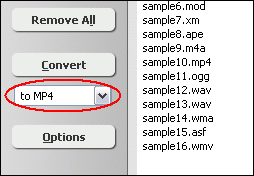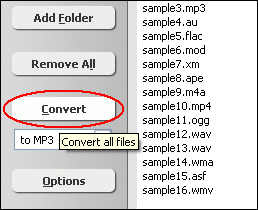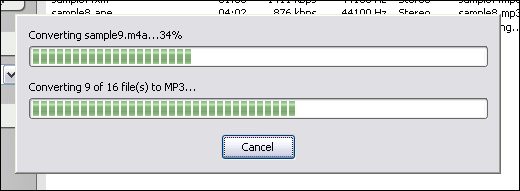MXF to MP4Convert MXF to MP4, MXF to MP4 Converter |
 |
| Home | Getting Started | Download | Buy Now! | Screen Shots | FAQ | Support | Contact |
MP4 MP3 Converter converts MXF files to MP4 format. The software is an all in one audio converter that supports more than 100 audio and video files. MP4 MP3 Converter also supports batch conversion, and is full compatible with Vista and Windows 7.
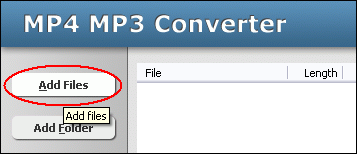 Click "Add Files" button to choose MXF files and add them to conversion list.  Choose one or more MXF files you want to convert and then click "Open". 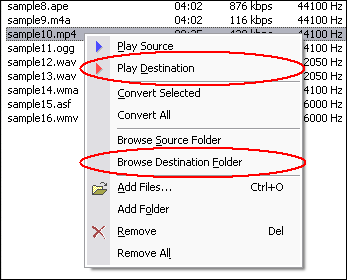 Right-click converted item and choose "Play Destination" to play the destination file, choose "Browse Destination Folder" to open Windows Explorer to browse the destination file. What is MXF? MXF has been designed by the leading players in the broadcast industry - with an enormous amount of input from the user community - to ensure that the format really meets their demands. It is being put forward as an Open Standard which means it is a file transfer format that is openly available to all interested parties. It is not compression-scheme-specific and it simplifies the integration of systems using MPEG and DV as well as future, as yet unspecified, compression strategies. This means that the transportation of these different files will be independent of content, and will not dictate the use of specific manufacturers¡¯ equipment. Any required processing can simply be achieved by automatically invoking the appropriate hardware or software codec. However, MXF is designed for operational use and so all the handling processes are seamless to the user. It just works quietly in the background. Besides offering better interoperability - working with video and audio between different equipment and different applications - its other major contribution is the transport of metadata. By developing MXF from the beginning as a new file format, considerable thought has gone into the implementation and use of metadata. Not only is this important for the proper functioning of MXF files, it will also enable powerful new tools for media management as well as improving the content-creation workflows by eliminating repetitive metadata re-entry. The changing technologies in television production, and in transmission to the viewers, means that the traditional methods for moving the content - programme video and audio - within studios is changing too. Not only is there far greater use of computers and IT-related products such as servers, but also the reliance on automation and the re-use of material have expanded. Besides the need to carry metadata, file transfers are needed to fit in with computer operations and they must be capable of being streamed for real-time operations. The development of the Material eXchange Format (MXF) is a remarkable achievement of collaboration between manufacturers and major organizations such as Pro-MPEG, the EBU and the AAF Association. It establishes interoperability of content between various applications used in the television production chain. This leads to operational efficiency and creative freedom through a unified networked environment. MXF is a "container" or "wrapper" format which supports a number of different streams of coded "essence", encoded with any of a variety of codecs, together with a metadata wrapper which describes the material contained within the MXF file. MXF was developed to carry a subset of the Advanced Authoring Format (AAF) data model, under a policy known as the Zero Divergence Directive (ZDD). This enables MXF/AAF workflows between non-linear editing (NLE) systems using AAF and cameras, servers, and other devices using MXF. What is MP4? MPEG-4 is a patented collection of methods defining compression of audio and visual (AV) digital data. It was introduced in late 1998 and designated a standard for a group of audio and video coding formats and related technology agreed upon by the ISO/IEC Moving Picture Experts Group (MPEG) (ISO/IEC JTC1/SC29/WG11) under the formal standard ISO/IEC 14496 - Coding of audio-visual objects. Uses of MPEG-4 include compression of AV data for web (streaming media) and CD distribution, voice (telephone, videophone) and broadcast television applications. MPEG-4 absorbs many of the features of MPEG-1 and MPEG-2 and other related standards, adding new features such as (extended) VRML support for 3D rendering, object-oriented composite files (including audio, video and VRML objects), support for externally-specified Digital Rights Management and various types of interactivity. AAC (Advanced Audio Coding) was standardized as an adjunct to MPEG-2 (as Part 7) before MPEG-4 was issued. MPEG-4 is still a developing standard and is divided into a number of parts. Companies promoting MPEG-4 compatibility do not always clearly state which "part" level compatibility they are referring to. The key parts to be aware of are MPEG-4 part 2 (including Advanced Simple Profile, used by codecs such as DivX, Xvid, Nero Digital and 3ivx and by Quicktime 6) and MPEG-4 part 10 (MPEG-4 AVC/H.264 or Advanced Video Coding, used by the x264 encoder, by Nero Digital AVC, by Quicktime 7, and by high-definition video media like Blu-ray Disc). Convert MXF to MP4 Related Topics: MPC to MP4, F4A to MP4, AC3 to MP4, APE to MP4, ALAC to MP4, F4B to MP4, SND to MP4, CAF to MP4, MMF to MP4, QCP to MP4, OMA to MP4, WV to MP4, UMX to MP4, MP4 to WAV, AAC to MP4, WMA to MP4, GSM to MP4, M4V to AAC, CDA to MP4, SOL to MP4, M4V to M4B, NSA to MP4, OGA to MP4, MLP to MP4, WAV to MP4, VOC to MP4, S3M to MP4, SPX to MP4, M4V to MP3, M4B to MP4, MPGA to MP4, M2A to MP4, MP3 to MP4, ULAW to MP4, XM to MP4
|
| Home | Getting Started | Download | Buy Now! | Screen Shots | FAQ | Support | Contact | Links |
| Copyright © 2008-2013 Hoo Technologies All rights reserved. Privacy Policy |
